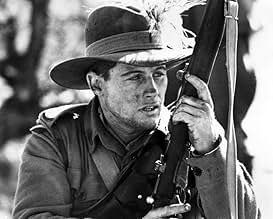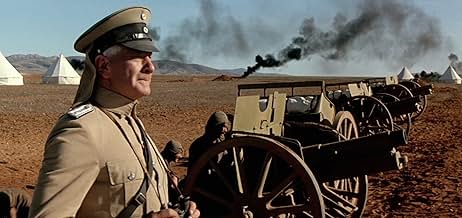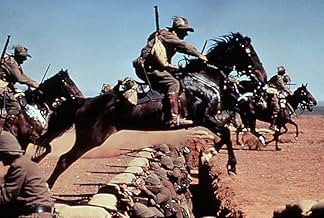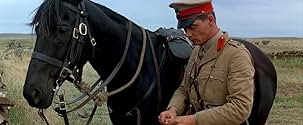IMDb RATING
6.8/10
2.2K
YOUR RATING
In 1917 when the British forces are bogged down in front of the Turkish and German lines in Palestine they rely on the Australian light horse regiment to break the deadlock.In 1917 when the British forces are bogged down in front of the Turkish and German lines in Palestine they rely on the Australian light horse regiment to break the deadlock.In 1917 when the British forces are bogged down in front of the Turkish and German lines in Palestine they rely on the Australian light horse regiment to break the deadlock.
- Awards
- 2 wins & 1 nomination total
Jack Heywood
- Dave's Dad
- (as John Heywood)
- Director
- Writer
- All cast & crew
- Production, box office & more at IMDbPro
Featured reviews
This is a story about some episode British-Turk campaign in Palestine in 1917. Very important role in this campaign was played by Australian forces. The key to conquer the Holy Land is city of Gaza. British general wants however to throw his forces to bypass the city and capture another one - Beersheba. To take them both it is necessary to keep his plan secret.
As a person who is interested in all WWI history I was waiting for this movie. I find it very good. All equipment seems to be very accurate, however, I've never heard about use of tanks in this front. There is a nice scene of air attack by German biplane, cars from that times, uniforms, and so on -- it all seems to be historical correct. The final charge is worth waiting for. I think that anyone who is interested in this campaign would be satisfied.
Because of Australian point of view the role of British army seems to be a little underrated. I especially mean British commander -- general Allenby. I think it would be good to say at the very end that after capturing Beersheba, Gaza fell as well a week later, and the road to Jerusalem was opened. This was what was lacking for me.
As a person who is interested in all WWI history I was waiting for this movie. I find it very good. All equipment seems to be very accurate, however, I've never heard about use of tanks in this front. There is a nice scene of air attack by German biplane, cars from that times, uniforms, and so on -- it all seems to be historical correct. The final charge is worth waiting for. I think that anyone who is interested in this campaign would be satisfied.
Because of Australian point of view the role of British army seems to be a little underrated. I especially mean British commander -- general Allenby. I think it would be good to say at the very end that after capturing Beersheba, Gaza fell as well a week later, and the road to Jerusalem was opened. This was what was lacking for me.
I saw only the last half of this one, appropriately enough on Anzac Day, tuning in just as the delicious Nurse Siggy Thornton is writing a love letter that intelligence Major Anthony Andrews is going to mislead Johnny Turk with. So I missed the alleged tedium of the first hour. The film is no doubt best viewed on a big screen, but what I did see in the last hour was the Australian Light Horse attack on Beersheba, brilliantly staged and filmed, with hundreds of horses and extras and tonnes of dramatic tension.
The actual battle was an Aussie military success, due in large part to their opponents, especially the Germans, underestimating them. It was a change from Gallipoli, where some of the horsemen had fought a couple of years earlier. It was terribly thoughtful of the Australian commanders to order the attack an hour before sunset when the light is best, and Dean Semler the cinemaphotographer takes full advantage of it. The close camera shots in the battle really give you the feeling you're right in it - there is nothing particularly original about "Saving Private Ryan" made 10 years later.
Yes, it's a cliché-ridden and chauvinistic script. The real villains are the Germans, all from Central Casting's Nazi division, despite this being a movie about the FIRST World War, but the British officers are also portrayed as pretty perfidious - the guys who made snobbery an art form to cover their incompetence. The Turks, though, are shown as brave and worthy opponents, if a little under the Germans' thumb. No doubt John Ford would have done it differently (I'm not sure he would have handled the horses any better) but this is the Australian point of view. A Turkish version would be interesting.
Anyway, worth it for the final battle.
The actual battle was an Aussie military success, due in large part to their opponents, especially the Germans, underestimating them. It was a change from Gallipoli, where some of the horsemen had fought a couple of years earlier. It was terribly thoughtful of the Australian commanders to order the attack an hour before sunset when the light is best, and Dean Semler the cinemaphotographer takes full advantage of it. The close camera shots in the battle really give you the feeling you're right in it - there is nothing particularly original about "Saving Private Ryan" made 10 years later.
Yes, it's a cliché-ridden and chauvinistic script. The real villains are the Germans, all from Central Casting's Nazi division, despite this being a movie about the FIRST World War, but the British officers are also portrayed as pretty perfidious - the guys who made snobbery an art form to cover their incompetence. The Turks, though, are shown as brave and worthy opponents, if a little under the Germans' thumb. No doubt John Ford would have done it differently (I'm not sure he would have handled the horses any better) but this is the Australian point of view. A Turkish version would be interesting.
Anyway, worth it for the final battle.
I have watched this movie at least five times. Initially, I was a little disappointed by the tedium of the first half of the movie. I began to realize, however, that the first half of the movie is a pretty good reflection of military life prior to the second half of the 20th century: long periods of boredom and routine punctuated by major confrontations.
I've noticed that a few reviewers have remarked on the final "cavalry charge," which suggests to me that they really weren't paying much attention to the movie. The final charge on the Turkish positions is so much more awe-inspiring given the usual tactics of the Lighthorsemen. One of the most thrilling moments is when the Aussies prepare to meet the enemy on horseback and, instead of pulling out the classic cavalrymen's sabers, draw their bayonets for the charge. You almost want to laugh at the sight of 16" knives against the well-emplaced Turks.
This is one of the few war movies based on actual events that is fairly accurate, too. Take a look at some of the sites dedicated to the 4th Light Horse Briagde and you will see what I mean. A letter from one of the actual participants to his brother is an almost perfect description of the events as shown in the movie.
**** out of ***** if only for the charge
I've noticed that a few reviewers have remarked on the final "cavalry charge," which suggests to me that they really weren't paying much attention to the movie. The final charge on the Turkish positions is so much more awe-inspiring given the usual tactics of the Lighthorsemen. One of the most thrilling moments is when the Aussies prepare to meet the enemy on horseback and, instead of pulling out the classic cavalrymen's sabers, draw their bayonets for the charge. You almost want to laugh at the sight of 16" knives against the well-emplaced Turks.
This is one of the few war movies based on actual events that is fairly accurate, too. Take a look at some of the sites dedicated to the 4th Light Horse Briagde and you will see what I mean. A letter from one of the actual participants to his brother is an almost perfect description of the events as shown in the movie.
**** out of ***** if only for the charge
Historically accurate and meticulously researched, this is one of the genre of "federation-era" war productions in the 1980's by the Australian film industry. The high-quality movies and mini-series of this collection included such titles as "Breaker Morant", "Gallipoli" and "ANZACS", and one can see obvious similarities in the techniques and methodology used in their production. This, however, does not detract from their appeal or their entertainment value; quite the reverse, in fact. The formula for this genre was to take an historically-documented campaign and translate it as faithfully as possible to the big screen, with emphasis on characterisation, accuracy of detail and background.
The formula works, because the characters are believable, and the situations, events and settings have been faithfully re-created. Much of the background and information for this genre came from personal diaries and military archives preserved over the years, which adds credence to the plots, the action and the stories.
"The Lighthorsemen" highlights the campaign of the Australian mounted rifles in the North Africa battleground of the Great War, and culminates with the last successful action of horse-riding troops in combat. Without giving away the story too much, the taking of Beersheba in the closing days of 1918 was a decisive event in military history, and the screen portrayal of this action will have you on the edge of your seat.
Masterful performances by Jon Blake, Shane Briant and Bill Kerr (all veterans of this movie formula,) the attention to detail, the drama, and the occasional humour make for a very entertaining movie. It's recommended viewing.
The formula works, because the characters are believable, and the situations, events and settings have been faithfully re-created. Much of the background and information for this genre came from personal diaries and military archives preserved over the years, which adds credence to the plots, the action and the stories.
"The Lighthorsemen" highlights the campaign of the Australian mounted rifles in the North Africa battleground of the Great War, and culminates with the last successful action of horse-riding troops in combat. Without giving away the story too much, the taking of Beersheba in the closing days of 1918 was a decisive event in military history, and the screen portrayal of this action will have you on the edge of your seat.
Masterful performances by Jon Blake, Shane Briant and Bill Kerr (all veterans of this movie formula,) the attention to detail, the drama, and the occasional humour make for a very entertaining movie. It's recommended viewing.
Despite the ubiquitous appearance by Sigrid Thorton, and my having to eat crow over my previous comments on Anthony Andrew's acting ability (no scenery chewing or hamming it up here), I very much enjoyed this outstanding Aussie film.
Simon Wincer has directed a wide variety of films, some bad (like the Cheryl Ladd waste of celluloid "Bluegrass" and the turkey "Pharlap") and some very good (like the intense "Harlequin" and the great A&E mini "PT Barnum"). I find this one to be particularly special due to it containing one of the best war sequences on film.
Wincer and his crew have excellently interwoven a beautifully done drama with incredible special effects. The battle sequence at the end if the film is so powerful that even seen on video on an average size home TV it is astounding. Not only is the Lighthorsemen's assault wonderfully choreographed, but the reaction shots of the cast are well performed. You can see the private struggles going on in the face of the big one.
This is not a movie for the faint of heart nor should it be dismissed as just another war movie by those a little leery of the genre.
Simon Wincer has directed a wide variety of films, some bad (like the Cheryl Ladd waste of celluloid "Bluegrass" and the turkey "Pharlap") and some very good (like the intense "Harlequin" and the great A&E mini "PT Barnum"). I find this one to be particularly special due to it containing one of the best war sequences on film.
Wincer and his crew have excellently interwoven a beautifully done drama with incredible special effects. The battle sequence at the end if the film is so powerful that even seen on video on an average size home TV it is astounding. Not only is the Lighthorsemen's assault wonderfully choreographed, but the reaction shots of the cast are well performed. You can see the private struggles going on in the face of the big one.
This is not a movie for the faint of heart nor should it be dismissed as just another war movie by those a little leery of the genre.
Did you know
- TriviaWebsite Cinephilia reports of the Jon Blake accident and legal case: "Jon Blake was critically injured whilst driving home on December 1, 1986, after the final day's filming of La chevauchée de feu (1987). He sustained severe brain injuries and in December, 1995, the New South Wales Supreme Court ruled that Blake should be compensated for the loss of potential earnings as a star in the United States. After taking evidence from actors, directors, and film critics who indicated his career could have been as big as Mel Gibson's, the court awarded him $32 million in damages. This was later reduced to $7 million after the defence appealed."
- GoofsAt the rest camp just after the 2 soldiers pass the British Major and addresses the Colonel about the men wearing shorts at the end the Colonel calls the Major 'Sir', this wouldn't happen as a Colonel is a higher rank to Major.
- Alternate versionsUK versions are cut by 6 secs to remove cruel horsefalls.
- ConnectionsEdited into Les aventures du jeune Indiana Jones: Palestine, October 1917 (1993)
- SoundtracksAUSTRALIA WILL BE THERE
Music and lyrics by W.W. 'Skipper' Francis
By Arrangement with Allans Music (Australia) Pty. Limited
- How long is The Lighthorsemen?Powered by Alexa
Details
- Release date
- Country of origin
- Official sites
- Language
- Also known as
- The Lighthorsemen
- Filming locations
- St. Kilda, Melbourne, Victoria, Australia(beach, Mediterranean Sea)
- Production companies
- See more company credits at IMDbPro
Box office
- Budget
- A$10,500,000 (estimated)
- Gross US & Canada
- $33,779
- Opening weekend US & Canada
- $23,645
- Apr 10, 1988
- Gross worldwide
- $34,514
- Runtime
- 2h 11m(131 min)
- Sound mix
- Aspect ratio
- 2.35 : 1
Contribute to this page
Suggest an edit or add missing content
















